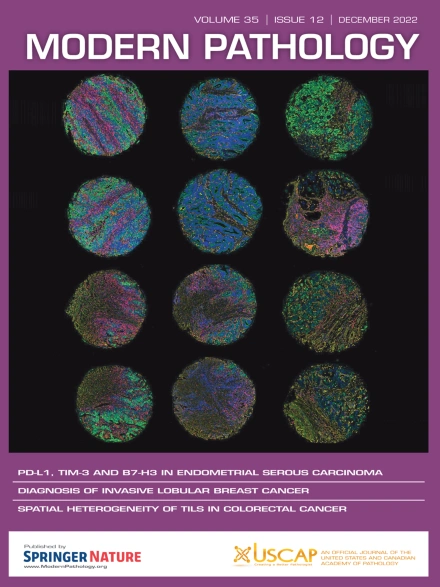PI3K-Akt信号在特发性多中心Castleman病的临床和病理表现中的作用——血小板减少症、贫血症、发热、网状蛋白纤维化和器官肿大以及其他未指定亚型
IF 5.5
1区 医学
Q1 PATHOLOGY
引用次数: 0
摘要
特发性多中心性Castleman病是一种罕见的淋巴细胞增生性疾病,临床分类为特发性浆细胞性淋巴结病(IPL);血小板减少、贫血、发热、网状蛋白纤维化和器官肿大(TAFRO);而非另外指明(NOS)。虽然每个亚型都表现出不同程度的血管扩张,但没有关于血管扩张程度的统计数据报道。此外,每种临床亚型的血管形成机制尚不清楚。在这里,我们旨在通过评估37名患者的每个临床亚型的组织病理学特征,并对血管生成相关基因表达进行全转录组分析,来阐明这些机制。组织学上,TAFRO和NOS血管化程度明显高于IPL (IPL vs TAFRO, P <;措施;IPL vs NOS, P = 0.002)。此外,TAFRO处理的生发中心(GCs)萎缩程度明显高于IPL处理。在TAFRO和NOS中,大多数病例可见GCs中的“漩涡血管”(TAFRO, 9/9, 100%;NOS, 6/8, 75%),但IPL没有(IPL vs TAFRO, P <;措施;IPL vs NOS, P = .007)。同样,免疫染色显示TAFRO组GCs内皮细胞中ets相关基因水平高于IPL组(P = 0.014), TAFRO和NOS与滤泡间区内皮细胞数量显著高于IPL组(TAFRO vs IPL, P <;措施;NOS vs IPL, P = 0.002)。基因表达分析显示,TAFRO和NOS (TAFRO/NOS)组PI3K-Akt信号通路显著富集。这一途径可能被血管内皮生长因子A和一些整合素激活,已知通过增加血管通透性来影响血管生成,这可能解释了TAFRO/NOS的无水和/或液体潴留的临床表现。这些结果提示PI3K-Akt通路在TAFRO/NOS的发病机制中起重要作用。本文章由计算机程序翻译,如有差异,请以英文原文为准。
The Involvement of PI3K–Akt Signaling in the Clinical and Pathological Findings of Idiopathic Multicentric Castleman Disease–Thrombocytopenia, Anasarca, Fever, Reticulin Fibrosis, and Organomegaly and Not Otherwise Specified Subtypes
Idiopathic multicentric Castleman disease is a rare lymphoproliferative disorder that is clinically classified into idiopathic plasmacytic lymphadenopathy (IPL); thrombocytopenia, anasarca, fever, reticulin fibrosis, and organomegaly (TAFRO); and not otherwise specified (NOS). Although each subtype shows varying degrees of hypervascularity, no statistical data on the degree of vascularization have been reported. Additionally, the mechanisms underlying vascularization in each clinical subtype are poorly understood. Here, we aimed to clarify these mechanisms by evaluating the histopathological characteristics of each clinical subtype across 37 patients and performing a whole-transcriptome analysis focusing on angiogenesis-related gene expression. Histologically, TAFRO and NOS exhibited a significantly higher degree of vascularization than IPL (IPL vs TAFRO, P < .001; IPL vs NOS, P = .002). In addition, the germinal centers (GCs) were significantly more atrophic in TAFRO than in IPL. In TAFRO and NOS, “whirlpool vessels” in GCs were seen in most cases (TAFRO, 9/9, 100%; NOS, 6/8, 75%) but not in IPL (IPL vs TAFRO, P < .001; IPL vs NOS, P = .007). Likewise, immunostaining for Ets-related gene revealed higher levels in endothelial cells of GCs in TAFRO than in IPL (P = .014), and TAFRO and NOS were associated with a significantly higher number of endothelial cells in interfollicular areas compared with that in IPL (TAFRO vs IPL, P < .001; NOS vs IPL, P = .002). Gene expression analysis revealed that the PI3K–Akt signaling pathway was significantly enriched in the TAFRO and NOS (TAFRO/NOS) groups. This pathway, which may be activated by vascular endothelial growth factor A and some integrins, is known to affect angiogenesis by increasing vascular permeability, which may explain the clinical manifestations of anasarca and/or fluid retention in TAFRO/NOS. These results suggest that the PI3K–Akt pathway plays an important role in the pathogenesis of TAFRO/NOS.
求助全文
通过发布文献求助,成功后即可免费获取论文全文。
去求助
来源期刊

Modern Pathology
医学-病理学
CiteScore
14.30
自引率
2.70%
发文量
174
审稿时长
18 days
期刊介绍:
Modern Pathology, an international journal under the ownership of The United States & Canadian Academy of Pathology (USCAP), serves as an authoritative platform for publishing top-tier clinical and translational research studies in pathology.
Original manuscripts are the primary focus of Modern Pathology, complemented by impactful editorials, reviews, and practice guidelines covering all facets of precision diagnostics in human pathology. The journal's scope includes advancements in molecular diagnostics and genomic classifications of diseases, breakthroughs in immune-oncology, computational science, applied bioinformatics, and digital pathology.
 求助内容:
求助内容: 应助结果提醒方式:
应助结果提醒方式:


